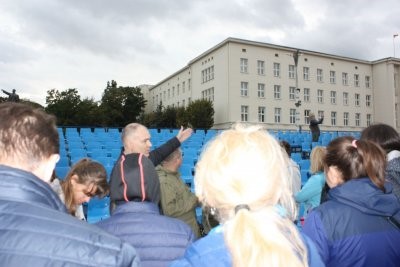The "Clasps and buttons with a rust eagle..." contest is an educational project carried out by the National Education Office of the Institute of National Remembrance in cooperation with the Katyń Museum in Warsaw. It is addressed to young people and secondary school teachers. The participants of this year's contest held for the 10th time had the task of creating a card for a family album about a specific Katyń Massacre victim. The prize for first degree laureates - authors and work content supervisors - was participation in the "Following the footsteps of Poles in Belarus" educational trip, which took place on 17-22 September 2019.
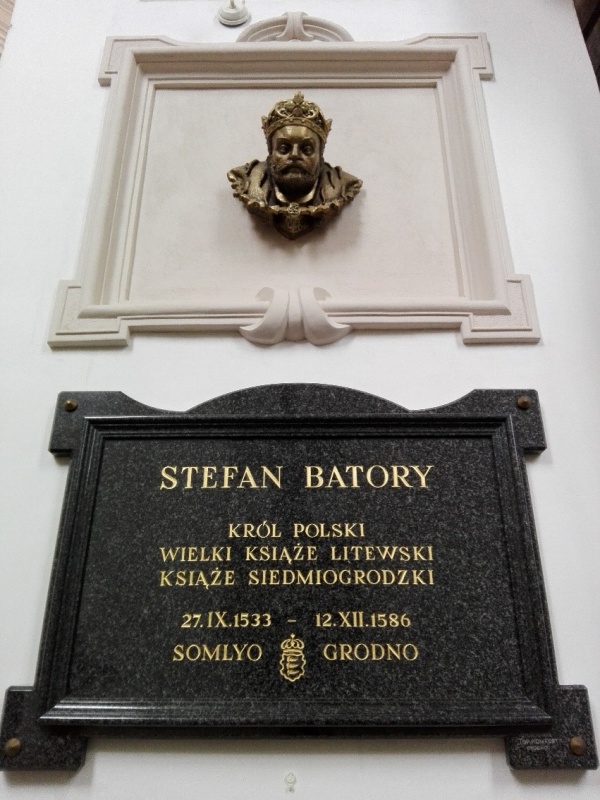
Students together with their guardians and trip organizers visited places inseparably connected with our history and culture: Brest, Pinsk, Sluck, Babruysk, Minsk, Kurapaty, Nesvizh, Navahrudak and Grodno.
Polesie, Poniemnie, Podźwinie, White and Black Ruthenia are historical parts of the former Grand Duchy of Lithuania, and the Poles living there still cultivate the heritage of the First Republic to this day. In Grodno, the participants of the expedition took part in the celebrations of the 80th anniversary of the city's defence against the Red Army in September 1939.
17 September
September 17, 1939 is one of the most important dates in the 20th century history of Poland. On that day, Soviet troops, implementing the provisions of the Molotov-Ribbentrop Pact of 23 August 1939, invaded the Second Republic of Poland. The fourth partition of Poland was symbolically complemented by a common, German-Soviet parade in Brest-Litowsk. Today, in the official Belarusian state propaganda and school textbooks, 17 September 1939 is the date of the "Union of Belarus". That is how the Soviets seizure of the eastern part of Mazovia, Podlasie, Polesie and Grodno for the benefit of the Byelorussian Soviet Socialist Republic is called.
Winners of the "Clasps and buttons with a rust eagle" contest started their "Following the footsteps of Poles in Belarus" journey on the 80th anniversary of this tragic event for Poland.
After crossing the border which runs along the Bug River, we reached Brest. We stood on Romuald Traugutt Square at the site of the parade. We saw the Polish state institutions buildings erected in the 1920s and 1930s. Through the eyes of our imagination we saw the German general Heinz Guderian and the Soviet commander Siemion Kriwoszyn, receiving a terrifying parade in front of the building of the Polish Office of Poleskie Voivodeship. Then we went to the area of the former fortress of the Second Polish Republic in Brest. The historical background of the events of 80 years ago was presented to the winners of the "Clasps ..." contest by Julia Lewandowska - tour leader, Artur Kolęda from the National Education Office of the Institute of National Remembrance and Tomasz Szczepański from the Katyń Museum.
18 September
The first full day in Belarus began with a visit to Pinsk. The legendary town on the Pripyat River is full of Polish themes. The most impressive monument is of course the Cathedral Basilica of the Assumption of the Blessed Virgin Mary, dating back to the beginning of the 18th century. Charmed by the magnificent baroque interior, we went to the crypt with the tomb of Kazimierz Świątek, Cardinal and Archbishop of the Minsk-Mylew Diocese. Father Edward Kryściak, S. P., who accompanied us on our journey, presided over the prayer for the soul of the priest and son of the legionary who died in 2011.
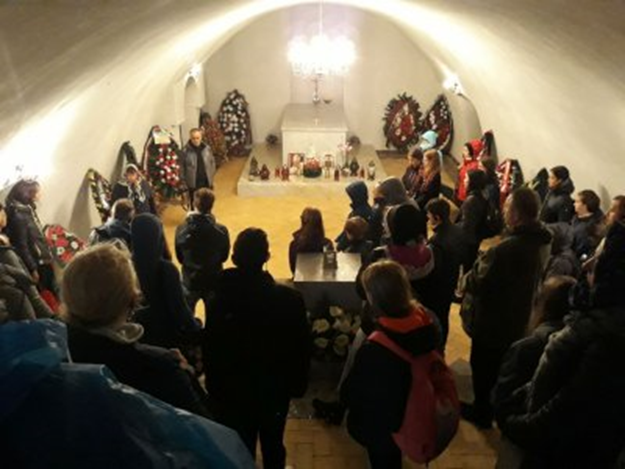
Then we went to the Baroque-Classicalist Butrymowicz Palace, founded in the 1880s by the starost of Pinsk, Mateusz Butrymowicz. In subsequent years it was owned by famous borderland families - Orda and Skirmuntt. At present, it serves the residents of Pinsk as a wedding palace.
Having entered the historic White Ruthenia, we visited Slutsk, once known to all the nobility of the Republic of Poland thanks to its beautifully decorated Slutsk sashes. Among other things, we saw the monument to Princess Zofia Slutskaya, the wife of Vilnius castellan Janusz Radziwill since 1600. The most eastern point of our journey was Bobrujsk, situated on the Berezina River, with its famous fortress captured on 3 February 1918 by the 1st Polish Corps of General J. Dowbór-Muśnicki. Together with the fortress and the city, Dowbór’s troops captured large warehouses with military supplies, ammunition and provisions. For a few months there was a free Poland - the "Bobruisk Republic". The 1st Corps remained there until May 1918. We ended the impressive day in Minsk, the capital of Belarus.
19 September
One of the most important points of our escapade was Kuropaty - a forest nature reserve on the northern outskirts of Minsk, where the Soviet NKVD carried out executions and buried corpses between 1937 and 1941. The victims were representatives of all nationalities living in the USSR, but mainly Belarusians and Poles. Today it is impossible to determine the total number of the buried; historians usually talk about 100-200 thousand. When it comes to Poles, these were murdered as part of the so-called Polish operation in 1937-1938 and the Katyń massacre in 1940. Today, there are more crosses and commemorative boulders installed in Kuropaty by organizations, associations, foundations and individuals related to the victims. The unfavourable conduct of the administration and services of President Lukashenko does not facilitate this, but even more so the winners of the "Clasps and buttons with a rust eagle" contest should have visited this place. We laid a bunch of white and red flowers from the Institute of National Remembrance, lit candles and said a prayer under the so-called Polish cross. The main element of the hill of crosses is a monument in memory of the victims of the totalitarian regime with a "heartless" bell, an internal element also called "language" in Belarusian.
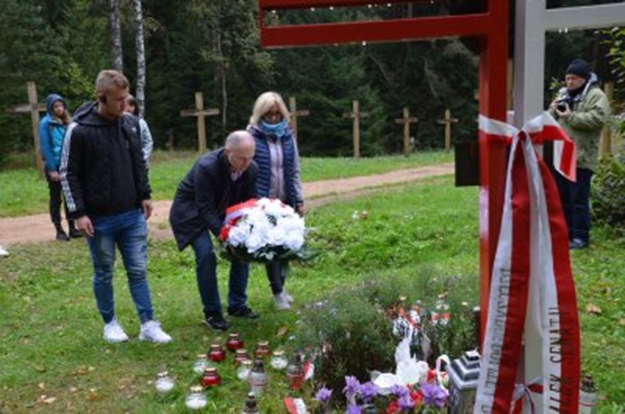
We started our tour of the city from the Church of St. Simon and St. Helena - the main Catholic temple of Minsk, founded in 1908 by Edward Voinilovich. Then we went to the Troickie Suburb and the Upper City, following in the footsteps of Benedict Dybowski, Stanisław Moniuszko, Tomasz Zan and Jerzy Giedroyc. The local architecture, streets, churches, memorial plaques and monuments are very similar to the old towns of Polish cities and towns. The largest church of the Upper City of Minsk was the St. Bernardine Church in the beautiful Polish Baroque style, founded by the Governor of Troki Alexander Słuszka between 1633 and 1642. After the January Uprising, the monastery was used by the tsarist authorities as an investigative prison for insurgents. In 1870 the monastery complex was taken over by the Orthodox Church and the church was converted into an orthodox cathedral. Currently an icon of Our Lady, the patron saint of Minsk is held there.
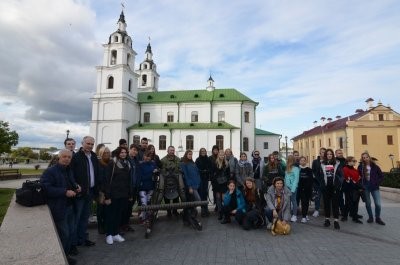
20 September
Nesvizh Castle is one of the most recognizable magnate residences in our country, although it has been outside its borders for several decades. It was the family seat of the Radziwiłł family, who for centuries gave the Republic of Poland chancellors, hetmans, voivodes and castellans. They looked at us today from countless portraits that we passed while visiting the magnificent Renaissance-Baroque palace. A lot can be written about every room and chamber of the residence and it wouldn't fully reflect the experience of a Pole visiting Nesvizh. It is a journey not only in space, but also in time - to the years of the greatest glory of the Republic of Poland, when our country was a model and an unrivalled ideal for others. The palace courtyard is dominated by a huge Radziwiłł coat of arms, the whole was surrounded by a perfect, still preserved defensive structure.
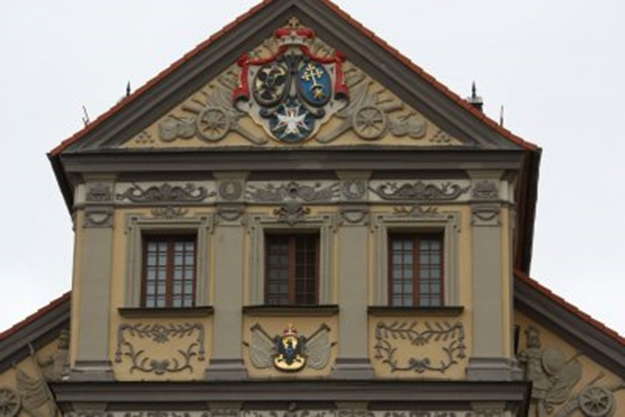
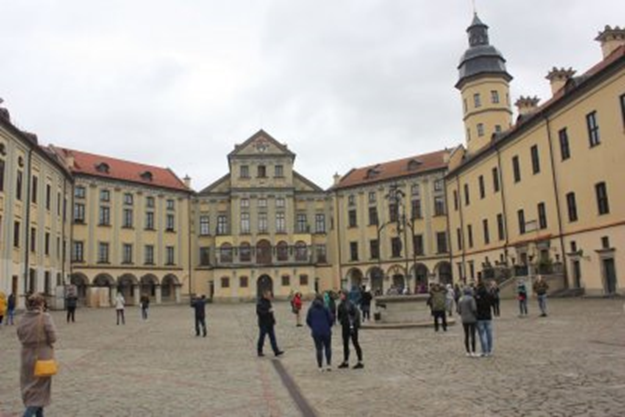

Full of emotions we went to Navahrudak, where we visited the manor house home to the Adam Mickiewicz Museum. No one was surprised by the information that almost half of those crossing his threshold were Poles.
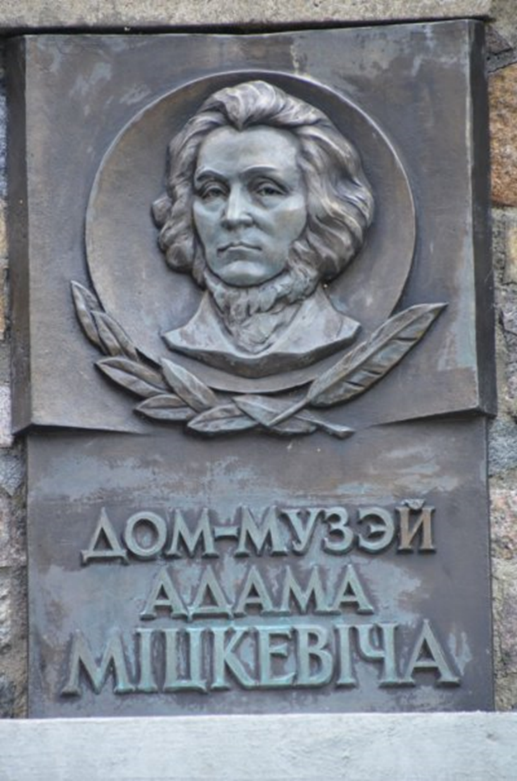
Across the Navahrudak region we rushed to the favourite city of King Stefan Batory - Grodno, to take part in the celebration of the 80th anniversary of the city's battle against the attacking Red Army in 1939, organized by the Poles living there. The roll call of the fallen took place before the Katyń Cross. Then the three winners of the 10th " Clasps and buttons with a rust eagle"..." competition laid a bouquet of flowers on the tombstone of Polish soldiers who died in the defence of Grodno in the September Campaign. The dedication on the sash was..: "To the defenders of Grodno in 1939 - Polish youth".
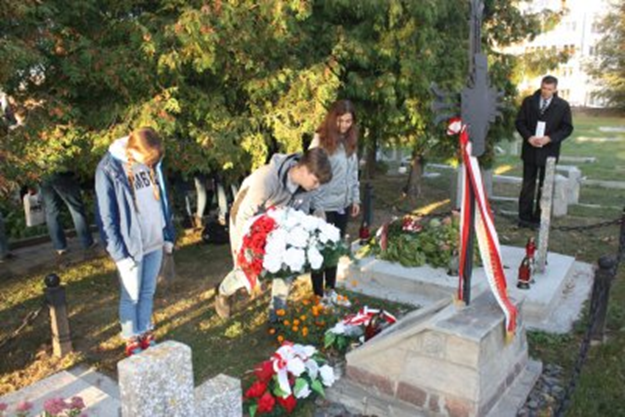
The celebration ended with a solemn Holy Mass in the Bernardine Church of the Finding of the Holy Cross, concelebrated by Father Edward Kryściak who was accompanying us.
21 September
The last day of our "Following the Footsteps of Poles in Belarus" tour started with laying a bouquet of flowers and lighting candles in memory of Polish soldiers killed in the Polish-Soviet War in 1920. The parish cemetery in Grodno is the last resting place of many outstanding Poles connected with this city, including Eliza Orzeszkowa.
The trail of her greatest work - "Nad Niemnem" - led us about 40 km upstream. The grave of John and Cecilia, known from the novels is there, and in the names of towns, commemorative plaques and grave slabs are written the families known throughout the Republic of Poland: Bohatyrowicz, Miniewicz, Skirmuntt, Hlebowicz and Poczobut. There are still Poles living there, proudly bearing these names and caring for the graves of the insurgents from 1863. We also lit white and red candles there, sang our national anthem and prayed for the souls of the fallen.
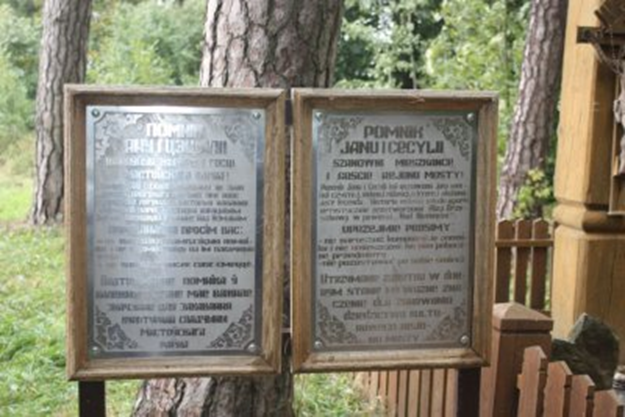
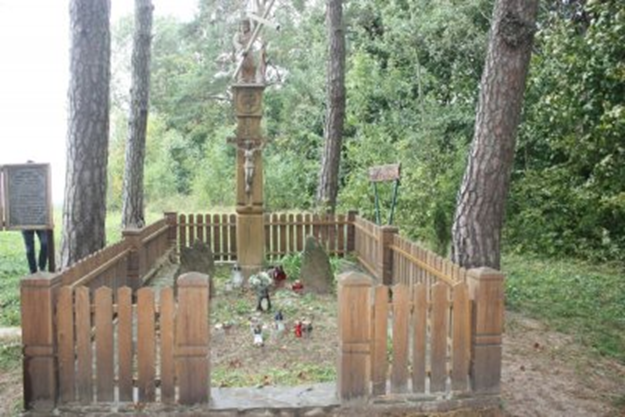
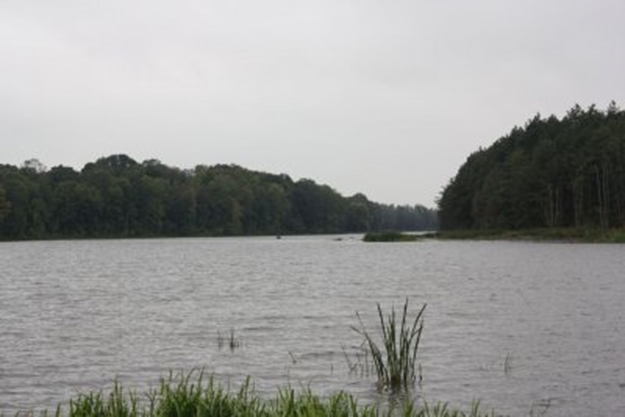
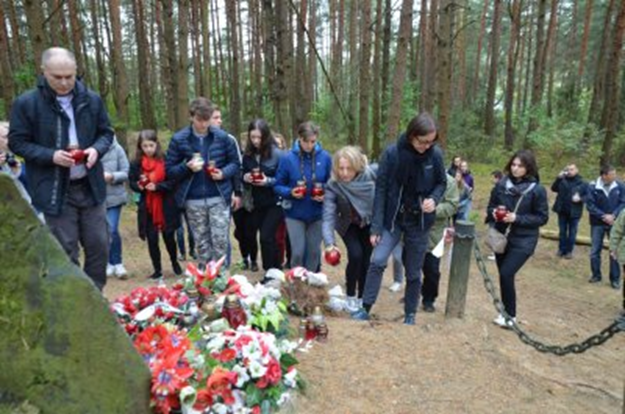
Our guide was Mr. Józef Porzycki - historian and teacher, author of many priceless publications describing the history of Grodno and the region. Thanks to him, we saw the Old Castle in Grodno and the New Castle in Grodno, which is currently being reconstructed. In its rooms during the last Polish Parliament in 1793, the Treaty of the Second Partition of Poland between Russia and Prussia was signed. In 1795 King Stanislaw August Poniatowski signed the abdication act. He lived in this palace until 1797. Since 1993, it has housed the State Historical and Archaeological Museum and in 1994, on the 200th anniversary of the Kosciuszko Insurrection, a plaque commemorating Tadeusz Kosciuszko was placed in the castle.
The pearl of Grodno is the Cathedral Basilica of St. Francis Xavier - originally a Jesuit church, from 1782 a parish church, and since 1991 a cathedral of the Roman Catholic diocese of Grodno. It is located at Stefan Batory Square, which Grodno had the greatest fondness for. There is a plaque in the temple dedicated to this king, and there are many other Polish diaspora and sacred treasures. The largest of them is of course the magnificent baroque main altar from 1737-1760. Two storeys are filled with rows of columns, between which there are statues of saints, apostles and Jesus Christ. At the top of the altar there are figures of its founder, the castellan of Mścisław Constance née Jundziłł Łazowa and of angels.

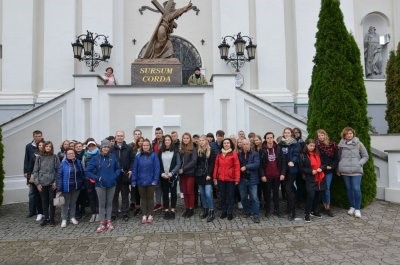
The final touch was a ceremony at the John Paul II Polish Community School in Grodno. The undersigned, Coordinator of the 10th "Clasps and buttons with rust eagle..." contest, handed the winners commemorative diplomas and gift sets prepared by the Office of National Education. He also provided the school management with educational materials and publications by the Institute of National Remembrance. The official part was followed by a meeting of the school's students and teachers with the winners of the contest.
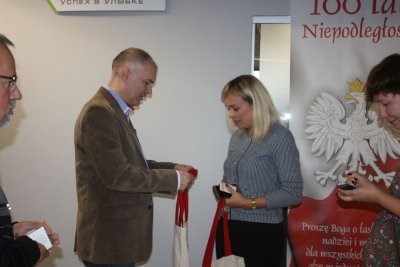
At 11:00 pm we set off on our journey back to Warsaw, which we reached early in the morning, on Sunday 22 September.
In 2020, we will celebrate the 80th anniversary of the Katyń massacre. The related contest and the educational trip, which is an award for the winners, will therefore have a special dimension and setting. Now it's time to meet the second degree winners of the 10th contest at the Katyń Museum in Warsaw and present them with their awards.
Artur Kolęda
The author is a historian, columnist and employee of the Institute of National Remembrance.
